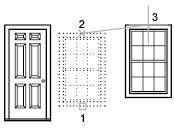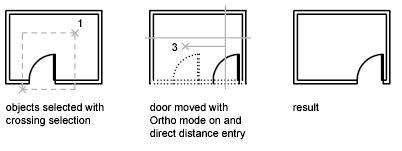You can move objects at a specified distance and direction from the originals.
Use coordinates, grid snap, object snaps, and other tools to move objects with precision.
Specify Distance with Two Points
Move an object using the distance and direction specified by a base point followed by a second point. In this example, you move the block representing a window. Select the object to be moved (1). Specify the base point for the move (2) followed by a second point (3). The object is moved the distance and direction of point 2 to point 3.

Use a Stretch-Move
You can also use STRETCH to move objects if all their endpoints lie entirely within the selection window. Turn on Ortho mode or polar tracking to move the objects at a specific angle.
A practical example is moving a door in a wall. The door in the illustration is entirely within a crossing selection, while the wall lines are only partly within the crossing selection area.

The result is that only the endpoints that lie within the crossing selection move.
Drag, Grip-Edit, or Nudge Objects
Move selected objects quickly by dragging , grip-editing, or nudging.
Drag objects within a drawing, or between open drawings and other applications. Dragging with the right button on the pointing device allows you to specify whether to move, copy, or create a block from the dragged objects. Dragging disregards all snap settings.
To nudge selected objects in orthogonal increments, press Ctrl + arrow keys. Snap mode affects the distance and direction in which the objects are nudged.
- Nudge objects with Snap mode turned off: Objects move two pixels at a time; movement is relative and orthogonal to the screen, regardless of the view direction or the UCS orientation.
- Nudge objects with Snap mode turned on: Objects are moved in increments specified by the current snap spacing; movement is orthogonal to the X and Y axes of the current UCS and relative to the view direction.